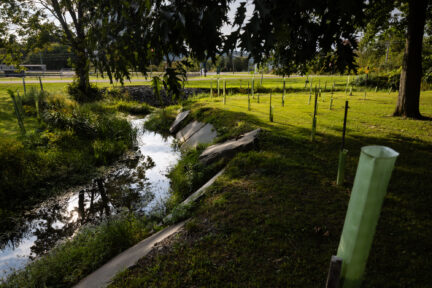2011 Levels of Dissolved Oxygen Lowest in Last Four Years
2011 Levels of Dissolved Oxygen Lowest in Last Four Years
In 2011, monitoring data collected by the Bay jurisdictions and other partners showed that dissolved oxygen (DO) concentrations in the Chesapeake fell to their lowest level in the last four years with 34 percent of the waters meeting the established standards for the summer months. This represents a decrease of 4 percent from the 2010 figures according to the Chesapeake Bay Program (CBP) partnership and is almost half of the higher DO values recorded a decade ago.
In spite of lower levels and in the face of many weather challenges, various Bay habitats and creatures that have been the target of restoration efforts showed resilience last year. In CBP news this March, scientists from Virginia Institute of Marine Sciences (VIMS) reported that despite a decrease in Bay grasses overall, the restored, healthy grass beds at Susquehanna Flats remained intact, widgeon grass beds grew (likely due to seed germination stimulated by lower salinities) and new grass beds were found in Virginia’s James River. In terms of fisheries, preliminary data by oyster scientists from Maryland Department of Natural Resources and NOAA showed good news, too. Experts estimate last year’s oyster survival rate was at its highest since 1985, oyster biomass increased 44 percent and oyster disease was at an all time low.
“Last year’s heavy rains and even this year’s early algae blooms and fish kills reinforce the critical importance of controlling polluted runoff reaching the Bay’s waters,” said Nick DiPasquale, Director of the Chesapeake Bay Program. “The survival rate of some oyster and grass beds in 2011 shows us that our efforts are working. By actively restoring and protecting valuable resources we can build a stronger, healthier Bay ecosystem that can withstand the forces of nature. Clearly, while we can’t control the weather, we can restore the watershed’s ability to survive its more extreme events. We know what works; we just need to do more of it.”
Experts were not terribly surprised by the final information on the Bay’s 2011 “dead zones” given the extreme weather. Between the very wet spring that sent excessive nutrients downstream, a hot, dry, early summer and more heavy rains accompanying Tropical Storm Lee and Hurricane Irene, conditions in the Chesapeake were bound to be affected.
Peter Tango, CBP Monitoring Coordinator and U.S. Geological Survey scientists explains, “The Bay ecosystem functions most effectively when fresh and salt water can mix, just like oil and vinegar need to mix to form salad dressing. A large fresh water influx such as that in 2011, along with intense heat, can result in vast differences in quantities of warm fresh and cool salt water in the Bay. These variables make it more difficult for water to mix vertically in the water column.”
In addition to vertical mixing, the dissolved oxygen levels in the Bay are also affected by what happens at the edges. Tango continues: “By the fall of last year, the Upper Bay became mostly fresh water due to rain. The Lower Bay became a hot tub due to heat,” illustrates Tango. “While the initial effects of the Tropical Storm Lee’s arrival was to mix the Bay more than usual in late summer, this combination of salinity and temperature conditions resulted in minimal levels of oxygen in bottom waters that lasted well into the fall (see image at left). The delay in autumn vertical mixing and the persistent summer-like water quality conditions at the northern and southern boundaries pushed on the mid-Bay waters, resulting in what we scientists call a
dissolved oxygen or ‘DO squeeze.’”
All of the Bay's living creatures – from the fish and crabs that swim through its waters to the worms that bury themselves in its muddy bottom – need oxygen to survive, although the amounts needed vary by species, season and location in the Bay. A DO squeeze challenges the health of fish, crabs, and other Bay creatures since they become compacted together – predator and prey, from north to south and bottom to top – in significantly smaller sections of water where and conditions are less-than-ideal for their survival.



